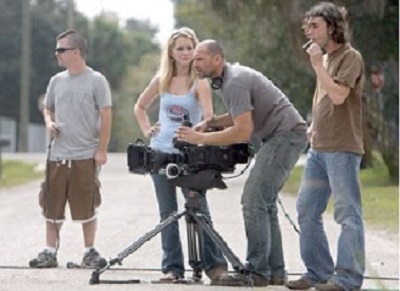Everybody knows what a producer, director, and cinematographer do. But what about all of those other jobs and names that follow, scrolling down the screen after as the movie ends? The gaffer, foley artist, and gang boss (not as rough and tumble as you might think) are a few film industry jobs that you’ve seen but maybe didn’t understand.
That includes the grip of a film, or in some cases, the grips. The grip department is responsible for building platforms, rigging, or other equipment needed to hold and secure production equipment. This could be a tower for the lighting department, a crane for the camera crew, or ways to deliver or hide cables for the electrical equipment.
The grips themselves won’t install lighting or cameras – that’s left to the respective departments. But they will take direction from the electrical department or director of photography. More often than not, these guidelines are handed down through the key grip or best boy or girl.
There is a hierarchy when it comes to jobs in feature films and television shows, and the grip department is no different. The top person in charge of the department is known as the key grip. The second in command is the Best Boy or Best Girl and the rest of the staff is filled with grips. The grips do much of the leg work and heavy lifting on a film set.
This could be as simple as setting up a tripod or building scaffolding to support a bank of lights on a sound studio. Grip equipment resembles the same tools that you might see at a construction site: hammers, drills, clamps, straps, and so on, but the most important tool in the belt is a crescent wrench.
This adjustable tool is used to tighten/loosen light standard clamps, pipe clamps, and a host of other equipment that uses different sized nuts and bolts. It’s like having a full wrench set – metric and standard – all wrapped into one.
 Many grips have a specific job. Dolly grips are responsible for securing, making, and operating dollies that allow cameras to move smoothly in a horizontal direction. This wheeled piece of equipment can move on a track, or independently, depending on the shot. Grips don’t make everything for a film, however.
Many grips have a specific job. Dolly grips are responsible for securing, making, and operating dollies that allow cameras to move smoothly in a horizontal direction. This wheeled piece of equipment can move on a track, or independently, depending on the shot. Grips don’t make everything for a film, however.
A grip rental agent will secure stands for lighting and other grip rentals that are often needed. For example, tripods don’t need to be made for every film, and it may be too expensive to buy a specific tripod for a single-use.
Grips must be able to work on the fly, altering construction to meet last-second changes from the film production higher-ups. This could be altering a stand to allow camera operators different camera angles for a particular scene. Grips working in the industry need to be versatile and adaptable.
Like many positions in the film industry, there isn’t necessarily a university program or film school that concentrates on grip work. The best way to get hired on as a grip is to first get experience in the field. Unfortunately, it’s not as easy as just showing up on the set with a tool belt.
Make Industry Connections
As with many industries, you’ll only get hired if you have experience. But if you don’t have any experience, how can you get hired? Film Connection may be the answer. Through our Cinematography Program, you’ll be placed inside a working production company, working side by side with a mentor.
There are many advantages to learning about making films, film videos, and television through Film Connection. It’s generally cheaper than 4-year universities or trade schools, your mentor is an industry insider, and you’ll get hands-on experience from day one. We’re also located in various cities and towns throughout the United States, so you won’t have to move to Los Angeles or New York for your education.
With Film Connection you have access you need to start making the connections that are so important in the movie-making business. If you’re responsible, do what you say you’re going to do, and continue to learn off the clock, you could get noticed by the very same professionals who do the hiring and who staff upcoming productions. Some of our graduates were even offered jobs before they finished the program. They put in the work to kick-start their careers.
Are you looking to learn and are ready to impress? Apply today.



